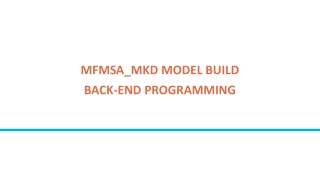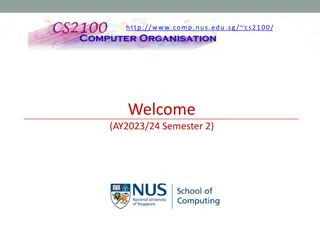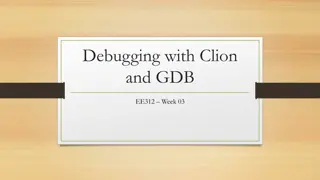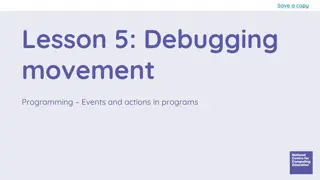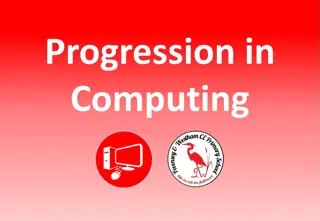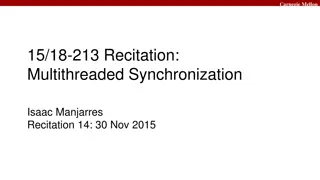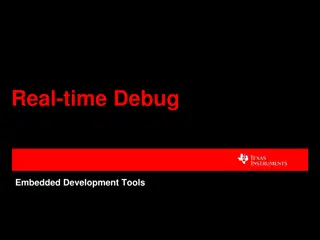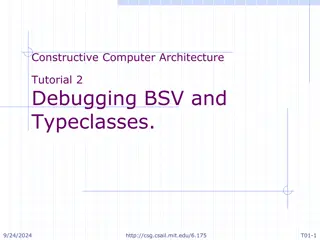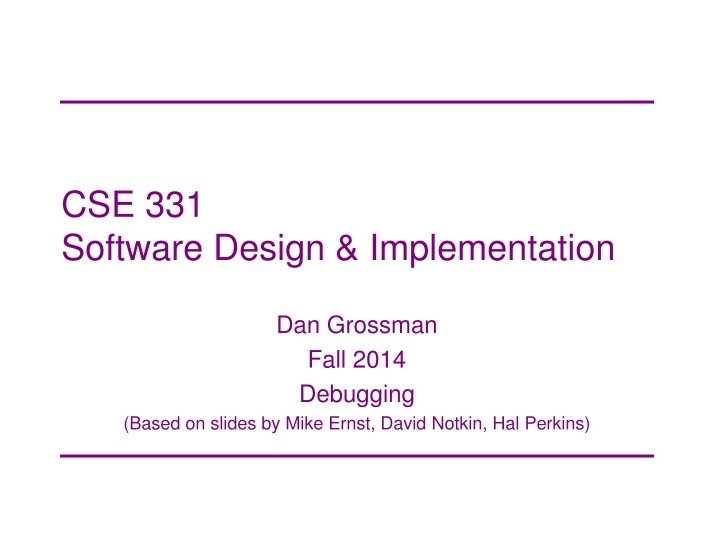
Effective Software Development Strategies and Defensive Programming Techniques
Discover ways to ensure code quality with verification, testing, and debugging. Learn about the importance of defensive programming, bug identification, and effective defense strategies for software development. Gain insights into preventing errors, making defects immediately visible, and utilizing the scientific method for debugging.
Download Presentation

Please find below an Image/Link to download the presentation.
The content on the website is provided AS IS for your information and personal use only. It may not be sold, licensed, or shared on other websites without obtaining consent from the author. If you encounter any issues during the download, it is possible that the publisher has removed the file from their server.
You are allowed to download the files provided on this website for personal or commercial use, subject to the condition that they are used lawfully. All files are the property of their respective owners.
The content on the website is provided AS IS for your information and personal use only. It may not be sold, licensed, or shared on other websites without obtaining consent from the author.
E N D
Presentation Transcript
CSE 331 Software Design & Implementation Dan Grossman Fall 2014 Debugging (Based on slides by Mike Ernst, David Notkin, Hal Perkins)
Ways to get your code right Verification/quality assurance Purpose is to uncover problems and increase confidence Combination of reasoning and testing Debugging Find out why a program is not functioning as intended Defensive programming Programming with validation and debugging in mind Testing debugging test: reveals existence of problem; test suite can also increase overall confidence debug: pinpoint location + cause of problem CSE331 Fall 2014 2
A Bugs Life defect mistake committed by a human error incorrect computation failure visible error: program violates its specification Debugging starts when a failure is observed Unit testing Integration testing In the field Goal is to go from failure back to defect CSE331 Fall 2014 3
Defense in depth Levels of defense: 1. Make errors impossible Examples: Java prevents type errors, memory corruption 2. Don t introduce defects get things right the first time 3. Make errors immediately visible Examples: assertions, checkRep Reduce distance from error to failure 4. Debug [last level/resort: needed to get from failure to defect] Easier to do in modular programs with good specs & test suites Use scientific method to gain information CSE331 Fall 2014 4
First defense: Impossible by design In the language Java prevents type mismatches, memory overwrite bugs; guaranteed sizes of numeric types, In the protocols/libraries/modules TCP/IP guarantees data is not reordered BigInteger guarantees there is no overflow In self-imposed conventions Immutable data structure guarantees behavioral equality finally block can prevent a resource leak Caution: You must maintain the discipline CSE331 Fall 2014 5
Second defense: Correctness Get things right the first time Think before you code. Don t code before you think! If you're making lots of easy-to-find defects, you're also making hard-to-find defects don't rush toward it compiles Especially important when debugging is going to be hard Concurrency, real-time environment, no access to customer environment, etc. The key techniques are everything we have been learning: Clear and complete specs Well-designed modularity with no rep exposure Testing early and often with clear goals These techniques lead to simpler software CSE331 Fall 2014 6
Strive for simplicity There are two ways of constructing a software design: One way is to make it so simple that there are obviously no deficiencies, and the other way is to make it so complicated that there are no obvious deficiencies. The first method is far more difficult. Sir Anthony Hoare Debugging is twice as hard as writing the code in the first place. Therefore, if you write the code as cleverly as possible, you are, by definition, not smart enough to debug it. Brian Kernighan CSE331 Fall 2014 7
Third defense: Immediate visibility If we can't prevent errors, we can try to localize them Assertions: catch errors early, before they contaminate and are perhaps masked by further computation Unit testing: when you test a module in isolation, any failure is due to a defect in that unit (or the test driver) Regression testing: run tests as often as possible when changing code. If there is a failure, chances are there's a mistake in the code you just changed If you can localize problems to a single method or small module, defects can usually be found simply by studying the program text CSE331 Fall 2014 8
Benefits of immediate visibility The key difficulty of debugging is to find the defect: the code fragment responsible for an observed problem A method may return an erroneous result, but be itself error- free if representation was corrupted earlier The earlier a problem is observed, the easier it is to fix In terms of code-writing to code-fixing And in terms of window of program execution Don t program in ways that hide errors This lengthens distance between defect and failure CSE331 Fall 2014 9
Don't hide errors // k must be present in a int i = 0; while (true) { if (a[i]==k) break; i++; } This code fragment searches an array a for a value k Value is guaranteed to be in the array What if that guarantee is broken (by a defect)? CSE331 Fall 2014 10
Don't hide errors // k must be present in a int i = 0; while (i < a.length) { if (a[i]==k) break; i++; } Now the loop always terminates But no longer guaranteed that a[i]==k If other code relies on this, then problems arise later CSE331 Fall 2014 11
Don't hide errors // k must be present in a int i = 0; while (i < a.length) { if (a[i]==k) break; i++; } assert (i!=a.length) : "key not found"; Assertions let us document and check invariants Abort/debug program as soon as problem is detected Turn an error into a failure Unfortunately, we may still be a long distance from the defect The defect caused k not to be in the array CSE331 Fall 2014 12
Last resort: debugging Defects happen people are imperfect Industry average (?): 10 defects per 1000 lines of code Defects happen that are not immediately localizable Found during integration testing Or reported by user step 1 Clarify symptom (simplify input), create minimal test step 2 Find and understand cause step 3 Fix step 4 Rerun all tests, old and new CSE331 Fall 2014 13
The debugging process step 1 find small, repeatable test case that produces the failure May take effort, but helps identify the defect and gives you a regression test Do not start step 2 until you have a simple repeatable test step 2 narrow down location and proximate cause Loop: (a) Study the data (b) hypothesize (c) experiment Experiments often involve changing the code Do not start step 3 until you understand the cause step 3 fix the defect Is it a simple typo, or a design flaw? Does it occur elsewhere? step 4 add test case to regression suite Is this failure fixed? Are any other new failures introduced? CSE331 Fall 2014 14
Debugging and the scientific method Home Debugging should be systematic Carefully decide what to do Don t flail! Keep a record of everything that you do Don t get sucked into fruitless avenues Use an iterative scientific process: Formulate a hypothesis Interpret results Design an experiment Perform an experiment CSE331 Fall 2014 15
Example //returns true iff sub is a substring of full //(i.e. iff there exists A,B such that full=A+sub+B) boolean contains(String full, String sub); User bug report: It can't find the string "very happy" within: "F ilte, you are very welcome! Hi Se n! I am very very happy to see you all." Poor responses: See accented characters, panic about not knowing about Unicode, begin unorganized web searches and inserting poorly understood library calls, Start tracing the execution of this example Better response: simplify/clarify the symptom CSE331 Fall 2014 16
Reducing absolute input size Find a simple test case by divide-and-conquer Pare test down: Cannot find "very happy" within "F ilte, you are very welcome! Hi Se n! I am very very happy to see you all." "I am very very happy to see you all." "very very happy" Can find "very happy" within "very happy" Cannot find "ab" within "aab" CSE331 Fall 2014 17
Reducing relative input size Can you find two almost identical test cases where one gives the correct answer and the other does not? Cannot find "very happy" within "I am very very happy to see you all." Can find "very happy" within "I am very happy to see you all. CSE331 Fall 2014 18
General strategy: simplify In general: find simplest input that will provoke failure Usually not the input that revealed existence of the defect Start with data that revealed the defect Keep paring it down ( binary search can help) Often leads directly to an understanding of the cause When not dealing with simple method calls: The test input is the set of steps that reliably trigger the failure Same basic idea CSE331 Fall 2014 19
Localizing a defect Take advantage of modularity Start with everything, take away pieces until failure goes away Start with nothing, add pieces back in until failure appears Take advantage of modular reasoning Trace through program, viewing intermediate results Binary search speeds up the process Error happens somewhere between first and last statement Do binary search on that ordered set of statements CSE331 Fall 2014 20
Binary search on buggy code public class MotionDetector { private boolean first = true; private Matrix prev = new Matrix(); no problem yet public Point apply(Matrix current) { if (first) { prev = current; } Matrix motion = new Matrix(); getDifference(prev,current,motion); applyThreshold(motion,motion,10); labelImage(motion,motion); Hist hist = getHistogram(motion); int top = hist.getMostFrequent(); applyThreshold(motion,motion,top,top); Point result = getCentroid(motion); prev.copy(current); return result; } } Check intermediate result at half-way point problem exists CSE331 Fall 2014 21
Binary search on buggy code public class MotionDetector { private boolean first = true; private Matrix prev = new Matrix(); no problem yet Check intermediate result at half-way point public Point apply(Matrix current) { if (first) { prev = current; } Matrix motion = new Matrix(); getDifference(prev,current,motion); applyThreshold(motion,motion,10); labelImage(motion,motion); Hist hist = getHistogram(motion); int top = hist.getMostFrequent(); applyThreshold(motion,motion,top,top); Point result = getCentroid(motion); prev.copy(current); return result; } } problem exists CSE331 Fall 2014 22
Detecting Bugs in the Real World Real Systems Large and complex (duh ) Collection of modules, written by multiple people Complex input Many external interactions Non-deterministic Replication can be an issue Infrequent failure Instrumentation eliminates the failure Defects cross abstraction barriers Large time lag from corruption (defect) to detection (failure) CSE331 Fall 2014 23
Heisenbugs In a sequential, deterministic program, failure is repeatable But the real world is not that nice Continuous input/environment changes Timing dependencies Concurrency and parallelism Failure occurs randomly Literally depends on results of random-number generation Bugs hard to reproduce when: Use of debugger or assertions makes failure goes away Due to timing or assertions having side-effects Only happens when under heavy load Only happens once in a while CSE331 Fall 2014 24
Logging Events Log (record) events during execution as program runs (at full speed) Examine logs to help reconstruct the past Particularly on failing runs And/or compare failing and non-failing runs The log may be all you know about a customer s environment Needs to tell you enough to reproduce the failure Performance / advanced issues: To reduce overhead, store in main memory, not on disk (performance vs stable storage) Circular logs avoid resource exhaustion and may be good enough CSE331 Fall 2014 25
More Tricks for Hard Bugs Rebuild system from scratch, or restart/reboot Find the bug in your build system or persistent data structures Explain the problem to a friend (or to a rubber duck) Make sure it is a bug Program may be working correctly and you don t realize it! And things we already know: Minimize input required to exercise bug (exhibit failure) Add more checks to the program Add more logging CSE331 Fall 2014 26
Where is the defect? The defect is not where you think it is Ask yourself where it cannot be; explain why Self-psychology: look forward to being wrong! Look for simple easy-to-overlook mistakes first, e.g., Reversed order of arguments: Collections.copy(src, dest); Spelling of identifiers: int hashcode() @Override can help catch method name typos Same object vs. equal: a == b versus a.equals(b) Deep vs. shallow copy Make sure that you have correct source code! Check out fresh copy from repository; recompile everything Does a syntax error break the build? (it should!) CSE331 Fall 2014 27
When the going gets tough Reconsider assumptions e.g., has the OS changed? Is there room on the hard drive? Is it a leap year? 2 full moons in the month? Debug the code, not the comments Ensure that comments and specs describe the code Start documenting your system Gives a fresh angle, and highlights area of confusion Get help We all develop blind spots Explaining the problem often helps (even to rubber duck) Walk away Trade latency for efficiency sleep! One good reason to start early CSE331 Fall 2014 28
Key Concepts Testing and debugging are different Testing reveals existence of failures Debugging pinpoints location of defects Debugging should be a systematic process Use the scientific method Understand the source of defects To find similar ones and prevent them in the future CSE331 Fall 2014 29

